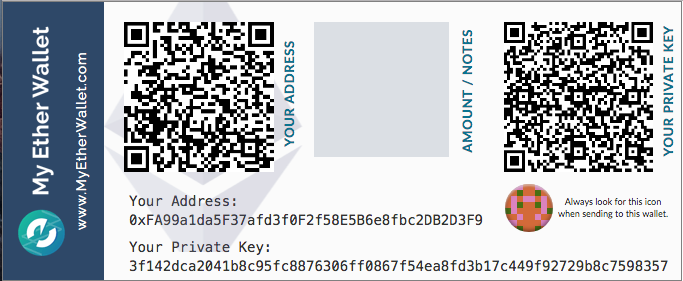A paper wallet is an offline method of storing Bitcoins with the public address and private key printed on a piece of paper.
Keeping your cryptos on an exchange is never a good idea. Due to hacks, scams, and other malicious reasons you should never keep your coins on an exchange except if you are looking to day or swing trade.
The infamous Mt Gox exchange at one point handled 70% of all Bitcoin transactions worldwide in 2014. A hack eventually caused investors close to 740,000 BTC. Imagine if those people kept the coins in an offline storage instead, the funds would still be available today.
It is certainly worth repeating. Keep cryptos in a wallet is always better than leaving the coins in an exchange. Practice security with your coins or you might end up like this guy:
While there are other options, such as a hardware wallet like a Trezor or a Ledger Nano S, various online and desktop software wallets, a paper wallet offers the following benefits:
Easy To Print
It is completely free to make and you can create as many as you like. Just print out more wallets if you would like to spread the funds over several ones.
To create a paper wallet all you need is a home printer, a laser one preferably. It is that simple.
Make sure you set your print settings and preview the results beforehand to make sure the public address and private keys are clearly visible and no parts of it are accidentally cut off.
Easy To Store
Paper wallet can be stored anymore. It can be be filed away in a cabinet, kept in a manila folder, or folded and put away in a stowaway box.
Make sure you remember the location because there is no way to retrieve any of the information if it is lost or stolen.
You are the fund’s sole keeper and the responsibility to protect the money falls squarely on your shoulders.
Cold Storage
Paper wallet is a good option if you don’t want to spend money on a hard wallet for offline storage. Since it is not connected to the Internet the risk of the funds being hacked is minimized.
With that being said you still need to be sure that the paper wallet is stored somewhere safe and not fall in the hands or prying eyes of individuals with ulterior motives.
Bitcoin Paper Wallet
To create your Bitcoin paper wallet:
Go to bitaddress.org or Walletgenerator.net, both are open-source random address and key generators that uses your browser’s JavaScript engine so no confidential information is ever sent over the Internet.
For this example, we will be using the bitaddress.org web site.

Download the web page and save it to your desktop.
Depending on the browser you are using there are different ways to do it. For example, on Firefox you can go to File > Save Page As…> Web Page, HTML Only

Next, turn Wi-Fi off to your computer so you are no longer connected to the Internet. This is a security precaution and will minimize any information from being compromised.

Now you are ready to open the web page that you have just saved to your desktop.
Start by moving your mouse all over the screen, to create some randomness. You can type in some texts to mix it up as well.

Once the percentage achieves 100% you will see the below screen.

Click on the Paper Wallet option and you will see three Bitcoin public addresses created with three corresponding private keys.
Note: you can change how many addresses are generated by entering a different number in the Addresses to generate field.

Additional security can be added to the private key if you choose BIP38 encryption. This is in case if you lose your paper wallet or if somebody comes across it they won’t be able to get access to your funds without knowing your passphrase as well.
Check the BIP38 Encrypt? box and enter a Passphrase and hit generate, you’ll see the below screen.

Now you are ready to print. You might want to Print preview first to make sure all the information are printed and nothing is cut off.
If everything looks good, create a printable copy by pressing the Print button.

That’s it!
You are now ready to send and receive Bitcoins with your new paper wallet.
Ethereum or ERC20 Wallet
The paper wallet that we just created it for storing and sending Bitcoins only.
What about Ethereum compatible tokens?
Those need to be stored on what is commonly called an ERC-20 wallet. A tool to create such a wallet is MyEtherWallet, more commonly known as MEW.
To get started with a MEW paper wallet go to https://www.myetherwallet.com. The web site has recently undergone a complete redesign and the old version of MEW is still accessible from the top link of the page.

Once the old version of the MEW page loads, it will default to the New Wallet tab.
Under Create New Wallet you will be able to Enter a password.
Then click on the Create New Wallet button.

Save your Keystore File to your computer by clicking onDownload Keystore File (UTC / JSON), make sure it is in a folder that is secure and kept secret from other users or guests.
A Keystore File is an encrypted version of your unique private key, which will be used to sign your transactions.
If, for whatever reason, you lose this file you will also lose access to your private key which means you won’t be able to retrieve your funds, so make sure it is kept somewhere that you don’t forget.
After you saved your Keystore File proceed by clicking on the I understand. Continue. button.

Your Private Key is now displayed.
Make sure to write it down and hide it or save it somewhere in a secure and secret location.
Just having your Private Key will give an individual complete control over your funds so make sure you guard this information as best you can.

Proceed to creating your paper wallet by clicking on the Print Paper Wallet button.
You will then see your wallet information, with both the Public Address and Private Key details along with the corresponding QR codes.
Just print from your computer and you can then start using this paper wallet for any ERC20 tokens.

Conclusion
It is always a good idea to store funds in an offline wallet.
Once such offline option is a paper wallet, which is quite easy to create, use and store away.
Bitcoin paper wallets can be created through the bitaddress.org web site.
Ethereum or ERC20 compatible paper wallets can be created through MyEtherWallet.
Tell us about your experience with creating your first paper wallet.
Was this tutorial helpful? Are there any other things we might have omitted that you would like discussed? Please let us know by commenting below.



